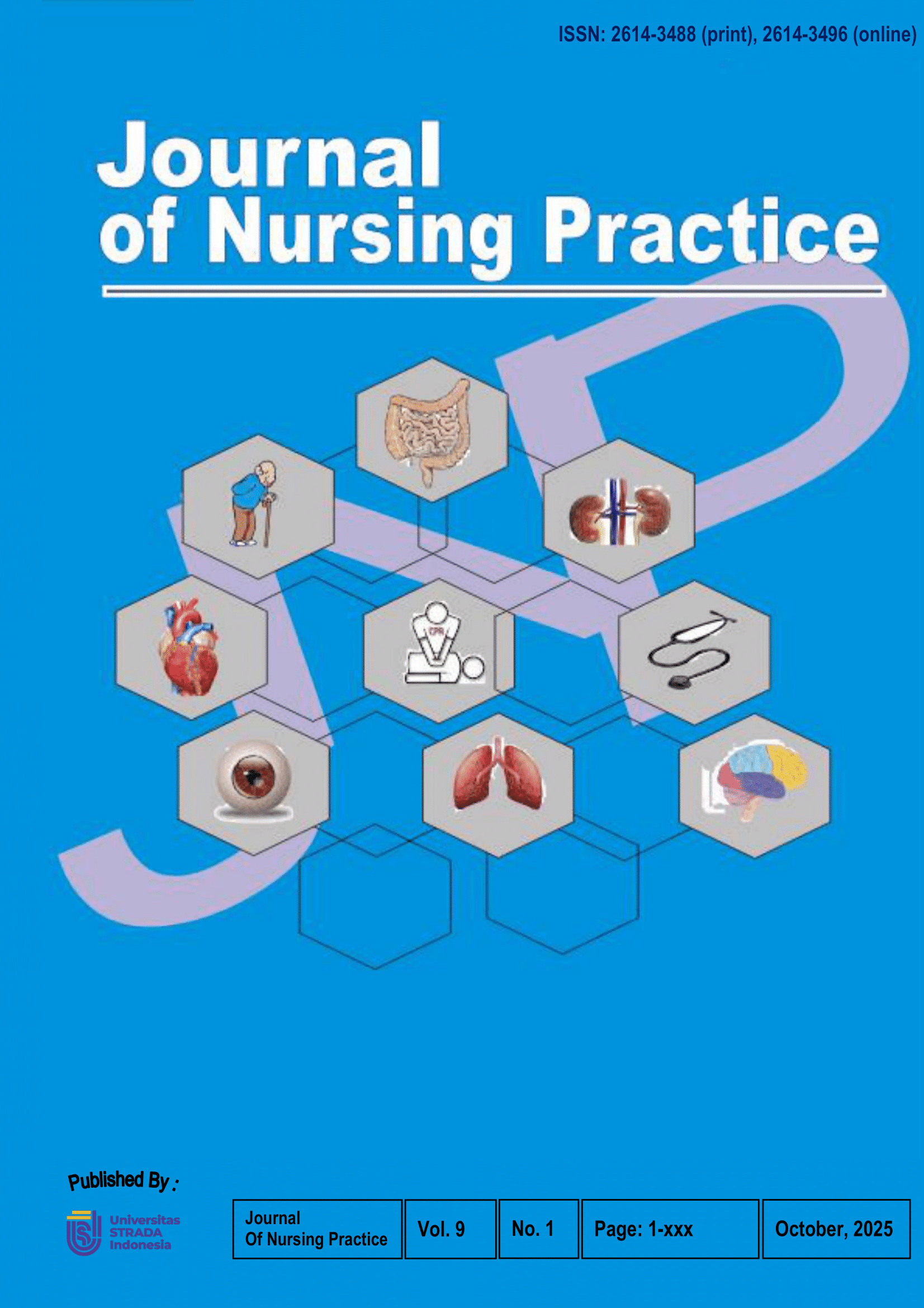Training Preschool Teachers in Early Detection of Emotional-Behavioral Problems and ADHD using Audiovisual and Booklet Media
DOI:
https://doi.org/10.30994/jnp.v9i1.925Keywords:
attention deficit-hyperactivity disorder, audiovisual aids, pre-school teachers, problem behavior, training programsAbstract
Background: Early identification of emotional and behavioral problems, including attention-deficit/hyperactivity disorder (ADHD), is essential for optimizing preschool children’s development. In Indonesia, many preschool teachers lack sufficient competence due to limited structured training. Evidence comparing audiovisual and booklet-based instructional media is scarce. This study addresses this gap, providing insights to enhance teacher preparedness in early detection.
Purpose: This study compared the effectiveness of audiovisual and booklet-based training programs in improving preschool teachers’ knowledge and skills in the early detection of emotional behavior problems and ADHD.
Methods: A quasi-experimental study with a non-equivalent group design was conducted among 58 preschool teachers selected through purposive sampling. Preschools were assigned to two formats that delivered identical training content through either audiovisual or booklet-based media. Participants’ knowledge was assessed using a questionnaire, and practical skills were evaluated with a checklist, both of which were validated and reliable. Data were analyzed using independent t-tests and Mann–Whitney U tests.
Results: Audiovisual training produced significantly greater improvements in participants’ knowledge (p < 0.001) and skills in early detection of emotional behavior problems (p < 0.001) and ADHD (p = 0.009) compared with booklet training. The audiovisual group achieved higher post-test scores and demonstrated better knowledge retention.
Conclusion: Audiovisual-based training was more effective than booklet-based training in enhancing preschool teachers’ knowledge and skills for identifying early emotional and behavioral problems in children. These findings highlight the importance of integrating audiovisual learning into teacher development programs to strengthen early childhood mental health surveillance.
Downloads
References
Abd Rahim, M. H., Ibrahim, M. I., Ab Rahman, A., Yaacob, N. M., & Hashim, N. S. F. (2023). Emotional and Behavioural Problems among Preschool Children in Northeast Peninsular Malaysia: Parent Report Version. Healthcare (Basel, Switzerland), 11(13), 1828. https://doi.org/10.3390/healthcare11131828.
Abdullah, A., Firmansyah, A., Rohman, A. A., Najamuddin, N., & Kuma, R. P. (2020). Health Education; The Comparison Between With Leaflet and Video Using Local Language In Improving Teenager’s Knowledge of Adverse Health Effect of Smoking. Faletehan Health Journal, 7(1), 48–51. https://doi.org/10.33746/fhj.v7i1.50.
Abdulrahaman, M. D., Faruk, N., Oloyede, A. A., Surajudeen-Bakinde, N. T., Olawoyin, L. A., Mejabi, O. V, Imam-Fulani, Y. O., Fahm, A. O., & Azeez, A. L. (2020). Multimedia tools in the teaching and learning processes: A systematic review. Heliyon, 6(11), e05312. https://doi.org/10.1016/j.heliyon.2020.e05312.
Aprianto, W. N., Sir, I., & Amir, A. (2022). Practice Of Audio-Visual Learning Media To Grow The Motivation Of MI Kenongomulyo Students’ Learning. Indonesian Journal of Research and Educational Review, 1(2), 137–144. https://doi.org/10.51574/ijrer.v1i2.271.
Ardiyati, S. P. (2015). Pelatihan Pemahaman ADHD Bagi Orangtua dan Guru Untuk Meningkatkan Kemampuan Deteksi Dini. Universitas Gadjah Mada, 2–18.
Arneliwati, Agrina, & Dewi, A. P. (2019). The effectiveness of health education using audiovisual media on increasing family behavior in preventing dengue hemorrhagic fever (DHF). Enfermeria Clinica, 29, 1–4. https://doi.org/10.1016/j.enfcli.2018.11.013
Ashary, Y., Rahamma, T., & Fatimah, J. M. (2015). Pengendalian Perilaku Emosional Anak TK Melalui Komunikasi Antara Guru Dengan Orang Tua Di Kec. Biringkanaya Kota Makassar. Komunikasi KAREBA, 4(4), 415–434.
Brame, C. J. (2016). Effective Educational Videos : Principles and Guidelines for Maximizing Student Learning from Video Content. 1–6. https://doi.org/10.1187/cbe.16-03-0125.
Cao, H., Yan, S., Gu, C., Wang, S., Ni, L., Tao, H., Shao, T., Xu, Y., & Tao, F. (2018). Prevalence of attention-deficit/hyperactivity disorder symptoms and their associations with sleep schedules and sleep-related problems among preschoolers in mainland China. BMC Pediatrics, 18(1), 70. https://doi.org/10.1186/s12887-018-1022-1.
Eshel, R., Wacht, O., & Schwartz, D. (2019). Real-Time Audiovisual Feedback Training Improves Cardiopulmonary Resuscitation Performance: A Controlled Study. Simulation in Healthcare : Journal of the Society for Simulation in Healthcare, 14(6), 359–365. https://doi.org/10.1097/SIH.0000000000000390.
Espigares-Tribo, G., & Ensenyat, A. (2021). Assessing an educational booklet for promotion of healthy lifestyles in sedentary adults with cardiometabolic risk factors. Patient Education and Counseling, 104(1), 201–206. https://doi.org/10.1016/j.pec.2020.06.012.
Fontenele, M. S. M., Cunha, G. H. da, Lopes, M. V. de O., Siqueira, L. R., Lima, M. A. C., & Moreira, L. A. (2021). Development and evaluation of a booklet to promote ealthy lifestyle in people with HIV. Revista Brasileira de Enfermagem, 74(5), 1–9. https://doi.org/10.1590/0034-7167-2020-0113.
Golzari, F., Hemati Alamdarloo, G., & Moradi, S. (2015). The Effect of a Social Stories Intervention on the Social Skills of Male Students With Autism Spectrum Disorder. SAGE Open, 5(4), 2158244015621599. https://doi.org/10.1177/2158244015621599.
Gunn, E. G. M., Ambler, O. C., Nallapati, S. C., Smink, D. S., Tambyraja, A. L., & Yule, S. (2023). Coaching with audiovisual technology in acute-care hospital settings: systematic review. BJS Open, 7(5). https://doi.org/10.1093/bjsopen/zrad017.
Harding, D., Kadiyono, A. L., Hidayat, Y., & Yanuarti, N. (2018). Pelatihan Dan Pengembangan SDM Sebagai Salah Satu Upaya Menjawab Tantangan MEA. Jurnal Psikologi Sains Dan Profesi, 2(2), 185–189.
Hasanica, N., Catak, A., Mujezinovic, A., Begagic, S., Galijasevic, K., & Oruc, M. (2020). The Effectiveness of Leaflets and Posters as a Health Education Method. Materia Socio Medica, 32(2), 135. https://doi.org/10.5455/msm.2020.32.135-139.
Herman, Rusmayadi, & Ilyas, S. N. (2021). Pendidikan Anak Usia Dini Holistik Integratif (PAUD-HI) di Kecamatan Tamalanrea Kota Makassar. Seminar Nasional Hasil Pengabdian, 97–100. https://ojs.unm.ac.id/semnaslpm/article/view/25639/12867.
Ho, L. Y. (2021). Current status of the early childhood developmental intervention ecosystem in Singapore. In Singapore Medical Journal (Vol. 62, Issue 1, pp. S43-52). https://doi.org/10.11622/smedj.2021076.
Holland, A., Smith, F., Mccrossan, G., Adamson, E., Watt, S., & Penny, K. (2013). Nurse Education Today Online video in clinical skills education of oral medication administration for undergraduate student nurses : A mixed methods , prospective cohort study. YNEDT, 33(6), 663–670. https://doi.org/10.1016/j.nedt.2012.01.006.
Jeffrey, B., Bagala, M., Creighton, A., Leavey, T., Nicholls, S., Wood, C., Longman, J., Barker, J., & Pit, S. (2019). Mobile phone applications and their use in the self-management of Type 2 Diabetes Mellitus: a qualitative study among app users and non-app users. Diabetology & Metabolic Syndrome, 11, 84. https://doi.org/10.1186/s13098-019-0480-4.
Kemenkes RI. (2018a). Laporan Nasional Riset Kesehatan Dasar (RISKESDAS) 2918. In Lembaga Penerbit Balitbangkes. Kementerian Kesehatan Republik Indonesia. https://repository.badankebijakan.kemkes.go.id/id/eprint/3514/1/Laporan Riskesdas 2018 Nasional.pdf.
Kemenkes RI. (2018b). Pedoman Pelaksanaan Stimulasi, Deteksi dan Intervensi Dini Tumbuh Kembang Anak. Kementerian Kesehatan Republik Indonesia.
Lima, A. C. M. A. C. C., Pinho, S. M. E. de, Lima, S. A. F. C. C., Chaves, A. F. L., Vasconcelos, C. M. T., & Oriá, M. O. B. (2022). Booklet for knowledge and prevention of HIV mother-to-child transmission: a pilot study of a randomized clinical trial. Revista Da Escola de Enfermagem Da U S P, 56, e20210560. https://doi.org/10.1590/1980-220X-REEUSP-2021-0560en.
Liu, Q., Geertshuis, S., Gladman, T., & Grainger, R. (2022). Student video production within health professions education: A scoping review. Medical Education Online, 27(1), 2040349. https://doi.org/10.1080/10872981.2022.2040349.
Merikangas, K. R., Nakamura, E. F., & Kessler, R. C. (2022). Epidemiology of mental disorders in children and adolescents. Dialogues in Clinical Neuroscience, 11(1), 7–20. https://doi.org/10.31887/dcns.2009.11.1/krmerikangas.
Moore, W. A., & Smith, A. R. (2012). Effects of video podcasting on psychomotor and cognitive performance , attitudes and study behaviour of student physical therapists. 49(4), 401–414.
Moreno, M. A., Binger, K., Zhao, Q., Eickhoff, J., Minich, M., & Uhls, Y. T. (2022). Digital Technology and Media Use by Adolescents: Latent Class Analysis. JMIR Pediatrics and Parenting, 5(2), 1–21. https://doi.org/10.2196/35540.
Morgado, M., Botelho, J., Machado, V., Mendes, J. J., Adesope, O., & Proença, L. (2024). Full title: Video-based approaches in health education: a systematic review and meta-analysis. Scientific Reports, 14(1), 23651. https://doi.org/10.1038/s41598-024-73671-7.
Nagamma, T., Ashok, L., Konuri, A., & Chandrasekaran, V. (2020). Effectiveness of audio-visual and print media intervention on knowledge of cervical health among rural women in Southern India. The Nigerian Postgraduate Medical Journal, 27(4), 343–347. https://doi.org/10.4103/npmj.npmj_148_20.
Nicolaou, C., Matsiola, M., Karypidou, C., Podara, A., Kotsakis, R., & Kalliris, G. (2021). Media Studies, Audiovisual Media Communications, and Generations: The Case of Budding Journalists in Radio Courses in Greece. Journalism and Media, 2(2), 155–192. https://doi.org/10.3390/journalmedia2020010.
Olusanya, B. O., Kancherla, V., Shaheen, A., Ogbo, F. A., & Davis, A. C. (2022). Global and regional prevalence of disabilities among children and adolescents: Analysis of findings from global health databases. Frontiers in Public Health, 10, 977453. https://doi.org/10.3389/fpubh.2022.977453.
Perosa Saigh Jurdi, A., Baptista da Silva, C. C., & Ferreira Roque Costa, D. (2023). The role of nursery school teachers in early intervention with children with signs of ASD. Frontiers in Education, 8(August), 1–9. https://doi.org/10.3389/feduc.2023.1237707.
Pratiwi, Y. F., & Puspitasari, D. I. (2017). Efektivitas Penggunaan Media Booklet Terhadap Pengetahuan Gizi Seimbang Pada Ibu Balita Gizi Kurang di Kelurahan Semanggi Kecamatan Pasar Kliwon Kota Surakarta. Jurnal Kesehatan, 10(1), 58–68.
Remesh, A. (2013). Microteaching, an efficient technique for learning effective teaching. Journal of Research in Medical Sciences : The Official Journal of Isfahan University of Medical Sciences, 18(2), 158–163.
Rosendahl, P., & Wagner, I. (2024). 360° videos in education – A systematic literature review on application areas and future potentials. In Education and Information Technologies (Vol. 29, Issue 2). Springer US. https://doi.org/10.1007/s10639-022-11549-9.
Shah, N., Mathur, V. P., Kathuria, V., & Gupta, T. (2016). Effectiveness of an educational video in improving oral health knowledge in a hospital setting. Indian Journal of Dentistry, 7(2), 70–75. https://doi.org/10.4103/0975-962X.184646.
Shaojie, T., Samad, A. A., & Ismail, L. (2022). Systematic literature review on audio-visual multimodal input in listening comprehension. In Frontiers in psychology (Vol. 13, p. 980133). https://doi.org/10.3389/fpsyg.2022.980133.
Sibualamu, K. Z., Murnihati, R. H., Mustafa, S. R., & Kusmayanti, E. (2023). Pengaruh Pendidikan Kesehatan terhadap Pengetahuan Ibu tentang Imunisasi Dasar Lengkap pada Bayi di Wilayah Kerja Puskesmas Jongaya. Jurnal Ilmiah Keperawatan Dan Kebidanan Holistic Care, 6(2), 1–5. https://jurnalgrahaedukasi.org/index.php/JIKKHC/article/view/262.
Sibualamu, K. Z., Mustafa, S. R., & Wahyuni, E. (2022). Pengembangan Edukasi Deteksi Dini Penyimpangan Perilaku Emosional Anak Prasekolah dengan Metode Blended Learning pada Guru PAUD. Jurnal Keperawatan Silampari, 6(1), 761–771. https://doi.org/https://doi.org/10.31539/jks.v6i1.4686.
Stacey, J. E., Atkin, C., Henshaw, H., Roberts, K. L., Allen, H. A., Justice, L. V., & Badham, S. P. (2022). Does audio-visual information result in improved health-related decision-making compared with audio-only or visual-only information? Protocol for a systematic review and meta-analysis. BMJ Open, 12(4), 10–13. https://doi.org/10.1136/bmjopen-2021-059599.
Taresh, S. M., Morett, L. M., Zaid, S. M., Roslan, S., Taleb, M. T., Song, P., Ahmad, N. A., & Noman, S. (2023). Preschool teachers’ knowledge, beliefs, and self-efficacy concerning autism: A parallel mixed-methods study of an intervention to improve autism identification. Autism, 0(0), 1–15. https://doi.org/10.1177/13623613231211850.
Tupou, J., Waddington, H., & Sigafoos, J. (2022). Teachers’ Perceptions of an Early Intervention Coaching Program. Advances in Neurodevelopmental Disorders, 6(4), 506–520. https://doi.org/10.1007/s41252-022-00267-5.
Uğur, Ç., Yürümez, E., & Yılmazer, Y. (2019). Emotional and behavioral problems in infants and preschool children: prevalence and sociodemographic risk factors. The European Research Journal, 5(1), 134–141. https://doi.org/10.18621/eurj.379887.
Ummah, F., Turlina, L., & Kusbiantoro, D. (2016). IbM Optimalisasi Peran Guru PAUD Untuk Meningkatkan Kualitas Tumbuh Kembang Anak Prasekolah. 147–154.
United Nations Children’s Fund (UNICEF). (2021). Seen, counted, included: Using data to shed light on the well-being of children with disabilities. https://data.unicef.org/wp-content/uploads/2022/12/Disabilities-Report_11_30.pdf?utm_source=chatgpt.com.
Valla, L., Wentzel-Larsen, T., Hofoss, D., & Slinning, K. (2015). Prevalence of suspected developmental delays in early infancy: Results from a regional population-based longitudinal study. BMC Pediatrics, 15(1), 1–8. https://doi.org/10.1186/s12887-015-0528-z.
Warren, R., Kenny, M., Bennett, T., Fitzpatrick-Lewis, D., Ali, M. U., Sherifali, D., & Raina, P. (2016). Screening for developmental delay among children aged 1-4 years: a systematic review. CMAJ Open, 4(1), E20–E27. https://doi.org/10.9778/cmajo.20140121.
Yu, M., Chair, S. Y., Chan, C. W. H., & Choi, K. C. (2015). A health education booklet and telephone follow-ups can improve medication adherence, health-related quality of life, and psychological status of patients with heart failure. Heart & Lung : The Journal of Critical Care, 44(5), 400–407. https://doi.org/10.1016/j.hrtlng.2015.05.004.
Zulaekah, S. (2012). Pendidikan Gizi Dengan Media Booklet Terhadap Pengetahuan. Jurnal Kesehatan Masyarakat, 7(2), 127–133.
Downloads
Published
How to Cite
Issue
Section
License
Copyright (c) 2025 Journal Of Nursing Practice

This work is licensed under a Creative Commons Attribution-NonCommercial-ShareAlike 4.0 International License.

This work is licensed under a Creative Commons Attribution-NonCommercial-ShareAlike 4.0 International License.






















